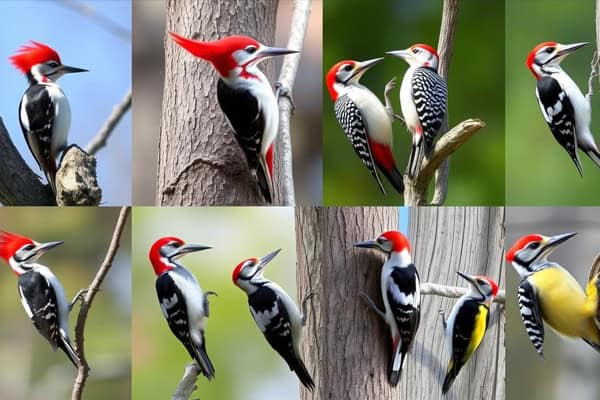11 Types of Woodpeckers in Arizona (With Pictures)
Did you know Arizona has over 11 woodpeckers? Each is unique, from the bright Gila woodpecker to the common Downy woodpecker. These birds are key to our state’s ecosystems.
Woodpeckers are a delight to watch. Their colors and sounds add beauty, and they help keep forests healthy.
In this article, we’ll examine Arizona’s woodpecker species and show you how to spot them with photos. Let’s explore Arizona’s woodpeckers together!
Introduction to Woodpeckers in Arizona
Arizona’s varied landscapes are home to many wildlife species, including woodpeckers. The state’s deserts and mountains host eleven unique woodpecker species. Watching these birds helps us learn about Arizona’s wildlife and its ecosystems.
Woodpeckers are known for their bright colors and special behaviors. Males have a red patch on their heads, while females do not. This makes them easy to spot for birdwatchers in Arizona.
In Southeastern Arizona, woodpeckers live in pine-oak woodlands at 4,000 to 8,000 feet. They nest and forage in these areas. They also make holes in dead trees for nests, helping other birds too.
Ornithologists recognize two woodpecker subspecies in Arizona: arizonae and fraterculus. The Gila Woodpecker and Gilded Flicker eat cactus fruits and insects. Their unique diet shows how important they are to the ecosystem.
Birdwatchers in Arizona love seeing woodpeckers. Their strong bodies and behaviors show the beauty of Arizona’s wildlife. It’s a chance to see the state’s rich biodiversity up close.
Woodpecker Species Overview
Exploring woodpeckers in Arizona shows us a wide range of birds. Each has its own special traits and ways of living, and we learn how they adapt to different places in the state.
Identifying woodpeckers is fun for both old and new birdwatchers. Arizona has many, like the Arizona woodpecker. It’s about 7 to 8 inches long. Males have a bright red spot on their heads, but females don’t. They make a sharp, squeaky sound that can be heard in the woods, similar to the calls of North American woodpeckers.
The Arizona woodpecker lives mainly in southern Arizona and parts of New Mexico and Sonora. It goes up into the Sierra Madre Occidental. Some say it might be in a different group of birds soon.
The northern flicker is another interesting woodpecker in Arizona. It lives in many places and environments, which helps us understand more about its life and how it fits into nature.
Woodpeckers eat insects and fruits. They use special ways to find food. This helps keep the ecosystem balanced by controlling insect numbers.
| Woodpecker Species | Length (inches) | Male Features | Call Description | Conservation Status |
|---|---|---|---|---|
| Arizona Woodpecker | 7-8 | There is a red patch on the nape | Sharp, squeaky Keech | Least Concern (IUCN 3.1), but populations can be impacted by habitat loss in Arizona and New Mexico. |
| Northern Flicker | 11-14 | No distinctive male feature | Various rhythmic calls | Least Concern (IUCN 3.1) |
| Gila Woodpecker | 8-9 | Black and white striped head | Chirps and drumming are common sounds from woodpeckers, including the American three-toed woodpecker. | Least Concern (IUCN 3.1) |
Learning about these birds helps us appreciate them more and become more aware of their homes in nature. Watching their calls and seeing their colors makes birdwatching in Arizona even better.
Importance of Woodpeckers in Ecosystems
Woodpeckers are very important in our ecosystems. They do many things that help our nature. Their work makes our ecosystems healthier.
Woodpeckers naturally control pests. They eat insects like termites and carpenter bees, keeping pest numbers in check, especially in places like Arizona.
They also spread seeds, helping plants grow. When they look for food, they move seeds around, helping plants grow in different places.
Woodpeckers make holes in trees, which helps other animals. These holes become homes for many creatures, showing how woodpeckers help ecosystems thrive.
In short, woodpeckers do a lot for our ecosystems. They help keep nature balanced and healthy. We should thank them for their hard work.
Common Woodpecker Species in Arizona
In Arizona, we see many woodpecker species. The three are especially interesting because of their looks and where they live. Knowing about these birds helps us appreciate Arizona’s rich wildlife.
1. Gila Woodpecker

The Gila Woodpecker loves the desert, especially the saguaro cactus. It has black and white stripes and a red crown. They make their homes in cacti, which is perfect for raising their babies.
They also like cottonwood trees by rivers. This shows they can live in different places.
2. Ladder-Backed Woodpecker

The Ladder-Backed Woodpecker, known for its black and white stripes, lives in the desert of southern Arizona and is also found in New Mexico, Texas, and Mexico.
It is interesting to watch it peck at tree bark. Its numbers are stable, showing that it fits well with other desert animals.
3. Northern Flicker

The Northern Flicker stands out because of its colors and its method of finding food. Unlike many woodpeckers, it searches for ants and beetles on the ground.
It can live in cities and the wild in Arizona, often seen around feeders in residential areas. As winter visitors, they add to the fun of birdwatching in towns.
| Woodpecker Species | Habitat | Distinct Features | Observation Frequency |
|---|---|---|---|
| Gila Woodpecker | Southern Arizona, Saguaro Cacti | Black and white striped plumage, reddish crown | Common |
| Ladder-Backed Woodpecker | Arid areas of Southern Arizona | Distinct black-and-white stripes | Common |
| Northern Flicker | Urban and natural areas | Ground forager, unique coloration | Prominent winter visitor |
Physical Characteristics of Each Species
Knowing the physical traits of woodpeckers can make birdwatching easier. It helps us tell apart different species in Arizona. Here, we look at three woodpeckers and what makes them unique.
4. Downy Woodpecker

The Downy Woodpecker is small, 5.5 to 6.7 inches long. It’s cute and has a short, chisel-like bill, which helps it find food easily.
It weighs 0.7 to 1 ounce. Its back has black-and-white stripes, characteristic of many species, including the Lewis’s woodpecker. Its wingspan is 10 to 12 inches, making it quick in the air.
5. Hairy Woodpecker

The Hairy Woodpecker is bigger, growing to 7.1 to 10.1 inches tall. It has a wingspan of 13 to 16 inches, typical for many species of North American woodpeckers. Its bill is also chisel-shaped, perfect for digging into wood and creating nest cavities.
It’s loved for its size and striking colors. Birdwatchers enjoy watching it move from tree to tree.
6. Acorn Woodpecker

The Acorn Woodpecker is known for its group nesting, which is a behavior observed in several North American woodpeckers. It’s 7.5 to 9.1 inches tall and has a wingspan of 14 to 17 inches. It weighs 2.3 to 3.4 ounces.
Its black-and-white feathers and red cap are eye-catching. It’s famous for storing acorns in granaries, which serve as a food source for many birds, including hummingbirds. This makes it easy to spot in Arizona.
| Species | Height (inches) | Wingspan (inches) | Weight (oz) |
|---|---|---|---|
| Downy Woodpecker | 5.5 – 6.7 | 10 – 12 | 0.7 – 1 |
| Hairy Woodpecker | 7.1 – 10.1 | 13 – 16 | 1.4 – 3.4 |
| Acorn Woodpecker | 7.5 – 9.1 | 14 – 17 | 2.3 – 3.4 |
Unique Nesting Habits of Woodpeckers
Woodpeckers have special ways of nesting. This shows how adaptable and unique they are. We’ll examine how Arizona woodpeckers choose their nests and what makes them special.
Nesting Locations and Preferences
Woodpeckers pick their nesting spots in different ways. For example, the Gila woodpecker loves nesting in saguaro cacti. This shows how well it can live in dry places.
These nests are often high up, from 12 to 35 feet. This helps them stay safe from predators and find food easily.
Here are some key nesting preferences for woodpeckers in Arizona:
- Gila Woodpecker nests are usually located in saguaro cacti and dead trees, allowing them to utilize the natural resources of their environment.
- Arizona Woodpeckers prefer oak and pine-oak woodlands, nesting in tree cavities ranging from 2 to 49 feet above the ground.
- Both species typically engage in excavation activities, creating cavities to suit their needs.
| Woodpecker Species | Nesting Height | Preferred Nesting Sites |
|---|---|---|
| Gila Woodpecker | 12 – 35 feet | Saguaro cacti, dead trees |
| Arizona Woodpecker | 2 – 49 feet | Oak, pine-oak woodlands |
Knowing how woodpeckers nest is key for protecting their homes. By keeping their habitats safe, we help these amazing birds thrive in Arizona.
Diet and Feeding Habits of Woodpeckers
Woodpeckers have a fascinating, unique way of eating. They help control insects, which is key to our ecosystem. Their diet changes with their environment, making them vital for balance.
Common Food Sources
Woodpeckers eat a variety of things:
- Insects like termites and carpenter bees
- Berries and fruits for sugar
- Nuts and seeds for nutrition
This variety helps woodpeckers thrive in forests, woodlands, and cities. It also keeps insect numbers down, making our environment healthier.
Foraging Techniques
Woodpeckers have special ways to find food:
- Drilling: They tap on trees to find insects, using their strong beaks.
- Sap feeding: They use their long tongues to get sap from trees. This is important when insects are scarce.
- Observational foraging: They watch bark for insect signs or listen for sounds, often near feeders that attract various birds.
These techniques help woodpeckers eat and control insects. They show how nature is connected and why we need diverse habitats.
Threats to Woodpecker Populations
Woodpeckers in Arizona face many dangers. Habitat loss from urban growth, logging, and climate change is a big problem, making it hard for them to find homes and food.
Conservation efforts are tough because of these threats. Laws like the Migratory Bird Treaty Act help, but breaking them is still a problem. For example, a company in Wisconsin was caught harming woodpeckers illegally.
Homeowners might harm woodpeckers without knowing it. They try to scare them away without understanding the laws. This can hurt the birds and the environment, particularly affecting species like the red-naped sapsucker.
Using bird netting can keep woodpeckers away from buildings. But, using fake birds or playing bird calls must be done right. People who want to harm birds must show they are financially struggling.
The Gila Woodpecker is losing ground due to lost homes and competition from other birds. This is very bad news. We need to protect their homes, especially in New Mexico and Arizona. We must work together to save these amazing birds.
Conservation Efforts for Woodpeckers
In Arizona, saving woodpeckers is very important. Groups work hard to fix their homes and teach good ways to live. The Arizona Game and Fish Department watches over woodpeckers and fixes their homes. This helps them live well.
The National Audubon Society has helped birds for over a hundred years. They make safe places for woodpeckers. The Nature Conservancy has also helped, protecting over 1 million acres in Arizona. These places are home to woodpeckers.
Universities like the University of Arizona and Northern Arizona University study woodpeckers. They learn how woodpeckers help the forest and keep water clean, as highlighted by studies from the Cornell Lab of Ornithology. The Southwest Fisheries Science Center also studies how woodpeckers stop fires and clean water.
But, woodpeckers are still in danger. They lose their homes and face climate change. We need to work together to save them. By helping and living sustainably, we can protect woodpeckers in Arizona.
| Organization | Conservation Initiative |
|---|---|
| Arizona Game and Fish Department | Monitoring populations and habitat restoration |
| National Audubon Society | Creating safe habitats for woodpeckers |
| The Nature Conservancy | Protecting over 1 million acres of woodpecker habitats |
| University of Arizona | Research on woodpecker ecology and conservation needs |
| Northern Arizona University | Research to promote woodpecker conservation efforts |
Woodpeckers of Arizona: Fascinating Facts
Woodpeckers are fascinating to bird lovers. In Arizona, we see many woodpecker species, each with its own special traits and habits.
Behavior and Vocalizations
Woodpeckers have unique behaviors. They drum on trees to communicate and attract mates, and their drumming pattern helps us tell them apart.
The Northern Flicker’s loud calls are a common sound in Arizona. Woodpeckers are social and often forage together. They play and gather food, especially outside breeding season.
Woodpeckers use their calls to stay connected and warn of danger. They also use them to find mates.
Let’s look at some interesting facts about woodpecker calls:
| Characteristic | Details |
|---|---|
| Drumming Speed | Up to 20 pecks per second |
| Daily Pecking Rate | Up to 12,000 pecks |
| Vocalization Ranges | Varies by species, each has unique calls |
| Nesting Behavior | Excavate cavities in dead wood, usually 16 feet above the ground |
Watching woodpeckers in Arizona shows us their importance in our ecosystems.
Read More🐦Related Articles:
| Snowy Owls (Bubo scandiacus) All You Need To Know |
| Crocodile Skink Facts, Size, Lifespan, Habitat, Diet, Pictures |
| What Do Hawks Eat |
| Yellow Birds in Colorado |
| White Birds in Hawaii |
Conclusion
We’ve examined 11 woodpecker species in Arizona, each found in different places along the Gila River. These birds are important for our environment. Some, like the Gila Woodpecker, live here all year, while others, like the Sierra Sapsucker, are seen less often.
Woodpeckers add fun to Arizona’s wildlife. The Gila Woodpecker makes homes for other birds. This shows how much we should appreciate them. They help keep our nature balanced.
Woodpeckers are amazing at building homes. This shows how connected our habitat is. We need to protect these birds.
It’s important to help these birds. By learning about them, we can improve Arizona’s wildlife. Let’s take care of our feathered friends and keep our landscapes beautiful.







